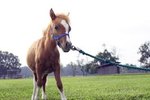As a dog owner, it is important to take note of abnormal behavior such as pacing. When abnormal behavior of any type is occurring, it is important to get in touch with the dog’s veterinarian for proper evaluation and treatment. In some instances, these abnormal behaviors can indicate a serious health issue.
What is Pacing?
Pacing is a type of walking movement signified more by the amount of movement rather than the gait itself. In dogs, pacing could be indicated by restlessness and the inability to simply sit down and relax. In some instances, pacing could simply indicate that the dog is anxious, such as waiting for the owner to return. However, pacing can also indicate more serious health issues.
Causes of Pacing
A canine can begin pacing for many different reasons, with some being serious health issues and others being completely normal. For example, herding breeds tend to pace more than other breeds, according to Susan Guyton, who is part of the American Veterinary Chiropractic Association. However, other, more serious causes of pacing can include injury or discomfort, spinal injury or degeneration. In large-breed puppies, pacing may occur because of bloat or because of various growth stages, with the dog pacing to compensate for the uneven growth.
Causes of Walking Backwards
Aside from the obvious answer of the dog being trained to walk backwards, there are actually relatively few reasons for a dog to engage in this type of movement. In fact, when examining a dog with potential health issues, the veterinarian will have the dog walk in a circle both clockwise and counterclockwise, as well as backwards, to determine if there is any neurological issues in the dog.
Treatment
Treatment is dependent entirely upon what is causing the pacing. For example, if a large-breed puppy is pacing excessively, and the veterinarian determines the cause to be bloat, then treatment is aimed at the bloat. Bloat is a serious health issue, and treatment is aggressive. Air must be removed from the stomach using a tube or large needle, X-rays are taken, and surgery is often needed to correct the position of the organs, including the stomach.
References
- "The Whole Dog Journal"; Signs That Your Dog is Suffering From Spinal Problems; Katie Margason-Moore; November 2001
- Pet Place; 21 Symptoms You Should Never Ignore in Your Dog; Debra Primovic
- PetEducation.com; Bloat (Gastric Dilation and Volvulus) in Dogs; Holly Nash
- University of Pennsylvania; Normal and Abnormal Gait; David M. Nunamaker et al.
Photo Credits
-
Jupiterimages/Photos.com/Getty Images





